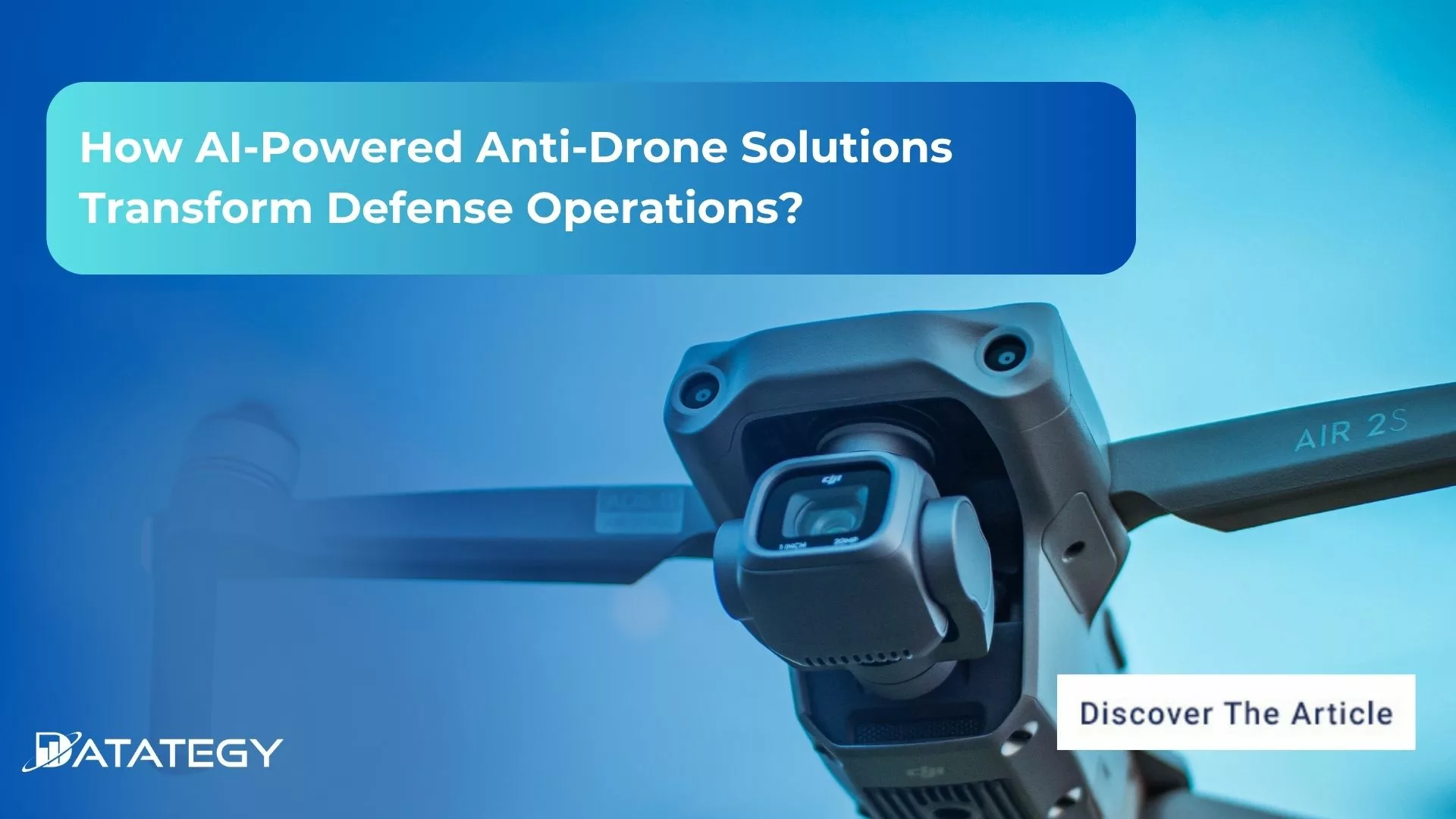We Don’t Just Build AI, We Deliver Measurable Impact Join...
Read MoreHow AI-Powered Anti-Drone Solutions Transform Defense Operations?
Table of Contents
ToggleDrones are everywhere these days. They deliver packages and take cool pictures from the sky. But this also means they can be used for bad things, like flying into places they shouldn’t. Keeping important areas safe from unwanted drones is a big worry for security teams. The answer often points to AI (Artificial Intelligence) helping to stop drones.
Simple methods of handling drones are no longer effective. Our defense must be clever. AI is particularly useful in this situation since it can assist us in locating, identifying, and preventing undesired drones. Even though we’re still working on completely automated systems that can respond instantly, particularly for complex live scenarios and intricate picture manipulation, tools like papAI are already making significant progress
They’re demonstrating how AI can begin to provide us with valuable knowledge, even in its early stages, by examining things like drone flight patterns and logged data. It’s all about leveraging data to predict potential threats and create a more intelligent, faster defense.
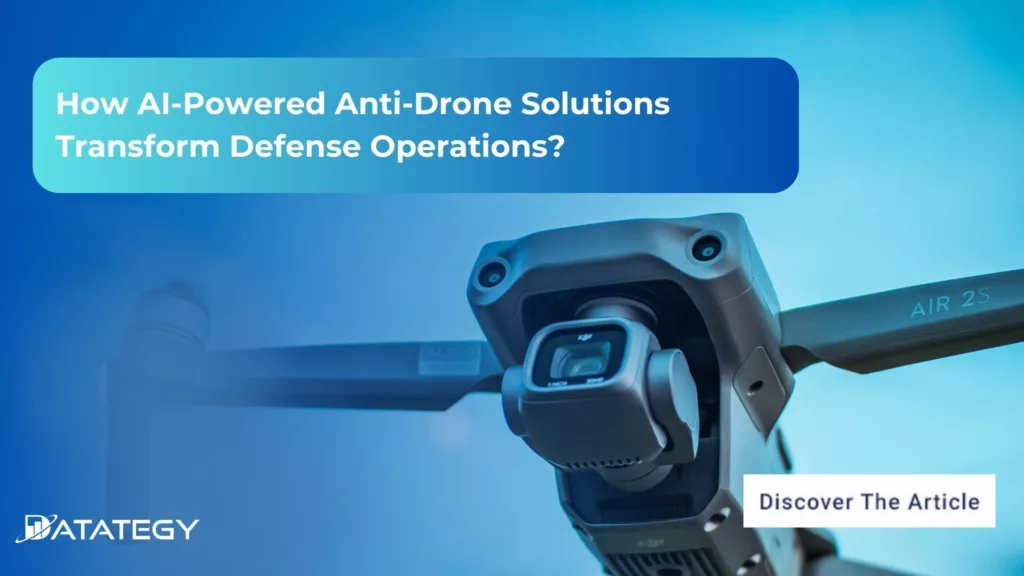
The anti-drone market is on a steep upward trajectory, with MarketsandMarkets™ forecasting a robust Compound Annual Growth Rate (CAGR) of 26.5% from 2025 to 2030. (Source)
What does an Anti-Drone System mean?
An anti-drone system is a collection of devices and technologies intended to identify, track, detect, and destroy hostile or unauthorized drones that enter restricted airspace. Drone misuse has increased along with the quick increase in drone use for both commercial and recreational purposes. This misuse can range from espionage and smuggling to threats against defense assets and key infrastructure. Radar, radio frequency (RF) scanners, acoustic sensors, cameras, and AI-driven analytics are just a few of the technologies that anti-drone systems use to monitor airspace and react to threats.
The system can use countermeasures to stop a drone from operating or safely bring it down after it has been detected. These defenses range from GPS spoofing and communication jamming to more sophisticated techniques like drone capture nets or directed energy weapons. Such systems are essential in defense situations to safeguard sensitive infrastructure, airports, and military bases against possible surveillance or attacks.
By providing real-time threat analysis, pattern recognition, and predictive insights to outmanoeuvre more complex drone technologies, the incorporation of AI into these systems further expands their capabilities.
Why AI Is Essential in Anti-Drone Systems?
1- Enhancing Detection Accuracy Through Complex Data Analysis
Accurately detecting and identifying drones in a variety of often crowded situations is a huge difficulty for anti-drone systems. Drones are more difficult to detect with standard radar or visual surveillance since they are smaller, quieter, and able to fly at low altitudes than traditional aerial threats. AI is invaluable in this situation. Large volumes of data from various sensors, including radar, radio frequency detectors, acoustic arrays, and visual cameras, can be processed by machine learning algorithms, which can then differentiate between drones and innocuous items like birds, kites, or even weather occurrences.
Pattern recognition and anomaly detection are areas in which AI models thrive. In addition to detecting the presence of a drone, they are able to identify its type and determine its purpose by analyzing flight paths, speed fluctuations, and radio frequency characteristics. For instance, AI can spot suspicious flight behaviors that differ from typical patterns, including lingering close to sensitive regions or making sudden altitude changes, by examining prior flight data. This degree of analysis guarantees that security teams concentrate on actual threats by significantly lowering false positives, a prevalent problem in non-AI anti-drone systems.
2- Real-Time Threat Assessment and Decision-Making
Important variables like the drone’s size, speed, flying direction, and closeness to vital infrastructure can all be instantaneously assessed by AI systems. Artificial intelligence (AI) systems can prioritise risks and recommend suitable responses by including contextual information, such as no-fly zones, time of day, and ongoing events. For instance, the algorithm might suggest watching rather than jamming a drone that is detected as a tiny recreational model flying close to a civilian area. This could have unexpected consequences for electronics in the vicinity.
Situational awareness is further improved in military applications by AI’s capacity to handle sensor fusion data, which combines radar, visual, and radio frequency inputs. Using terrain analysis and historical trends, it may also forecast the probable target of a drone. Preemptive actions, such sending out counterdrones or turning on electronic warfare systems before the threat manifests, are made possible by this predictive capabilities. Human operators can concentrate on supervision and strategic decision-making instead of manual monitoring and assessment by assigning these time-sensitive analyses to AI.
3- Adaptive Countermeasure Deployment for Diverse Threats
Modern anti-drone operations need dynamic response mechanisms that can adjust to various situations in addition to detection. AI gives anti-drone systems the ability to analyse threats in real time and choose and implement the best countermeasure. This is important since there are many different types of drones, from GPS-guided commercial drones to highly customised autonomous vehicles used in terrorist or military activities.
An AI-powered system can choose automatically from a collection of countermeasures, including directed energy weapons, GPS spoofing, RF jamming, and net-based drone capture. Targeting particular drone models while reducing collateral interference with adjacent civilian electronics or infrastructure is possible by adjusting factors like the jamming frequency or power levels. Multi-layered defense techniques are also supported by AI, which coordinates many countermeasures at the same time to deal with swarms or numerous incursions.

AI in anti-drone systems is no longer optional; it’s the brain that turns raw sensor data into actionable defense. With papAI, we’re enabling defense teams to move from detection to prediction, ensuring airspace security against evolving drone threats.
Thibaud Ishacian
Head of Product - Datategy
What are the Core Features of AI-Powered Drone Defense
1- Advanced Multi-Sensor Fusion for Robust Detection & Classification
Modern anti‑drone systems must juggle data from radars, RF scanners, cameras, and acoustics—often in complex environments with birds, kites, or interference. AI acts as the central intelligence, seamlessly integrating these disparate data streams to recognize drones with astounding precision. For instance, research shows AI‑enabled surveillance systems improve target detection accuracy by up to 40% compared to traditional methods.
This increased precision is essential because, without smart fusion, systems can misidentify innocuous objects or miss covert drones. Deep learning algorithms, however, are able to identify minute characteristics that set drones apart from harmless objects, such as distinct rotor blade pitches or radio frequencies. As a result of ongoing machine learning, these systems become increasingly intelligent over time, lowering false alarms by adjusting to new drone models and behaviors.
2- Adaptive, Context-Aware Countermeasure Deployment
Not every drone intrusion calls for the same reaction, and AI makes sure that the appropriate reaction is given in each case. AI can dynamically select techniques that eliminate threats while minimising collateral damage when combined with electronic warfare instruments like jammers or spoofers. When properly targeted, soft-kill techniques like RF jamming stop rogue drones without interfering with neighbouring GPS or telecommunications networks.
Furthermore, AI keeps improving its methodology. Performance information (such as the time it takes to turn off a drone or collateral interference) is incorporated into the learning loop following each interaction. Over time, this feedback results in more intelligent strategies. Research in AI anti-drone markets indicates that AI-powered smart jammers have been drastically decreasing needless counteractions and reducing false alerts by 90% (Wikipedia).
In urban or mixed-use settings, this combination of automation and contextual awareness guarantees that anti-drone systems continue to be accurate, effective, and cause the least amount of disturbance to neighbouring systems.
3- Predictive Behavior Analysis from Tabular Logs
Drone flight paths, speed, altitude, timestamps, and control signals are all contained in tabular logs, which are structured data tables. However, because of their sheer number and complexity, they are frequently underutilised in defense situations when used alone. By examining these records to find trends that humans might overlook, AI alters this dynamic. In order to identify anomalies, recurring patterns, and minute variations in flight patterns that might indicate surveillance, reconnaissance, or an impending threat, it uses machine learning to sort through millions of rows.
An AI model might see, for instance, that a drone frequently hovers at particular coordinates for a little longer periods of time during various flights, indicating that the drone is collecting imagery. It is impossible to perform this level of analysis by hand. Studies reveal that, when compared to rule-based systems, AI systems that analyse structured aviation data can increase anomaly detection rates by as much as 65% (MarketsandMarkets). By employing tabular logs as real-time situational tools rather than merely archives, defense teams can respond more quickly and intelligently.
4- Scalable Solutions for Large-Scale Data
Large amounts of structured drone flight data are produced by several locations that are frequently monitored during modern defense operations. Predictive behavior analysis may be scaled across various datasets by AI, guaranteeing thorough coverage without taxing humans or systems.
Terabytes of tabular logs from radar stations, RF sensors, and even crowdsourced observations may be handled by AI platforms like Datategy’s papAI using distributed processing and sophisticated machine learning techniques. This scalability is essential as enemies use autonomous UAVs or drone swarms more frequently. Businesses may analyse up to 50 times as much data while retaining real-time insights when AI is used in military data analytics, according to Deloitte (Deloitte Insights).
Even when monitoring hundreds of drone flights at once, operators can rapidly understand situational awareness thanks to AI-powered dashboards that can display these findings in easily navigable visualisations. This comprehensive approach guarantees that defense systems continue to function well in situations with multiple threats and significant levels of change.
Which types of AI technologies is used in Anti-Drone Solutions
1- Machine Learning
Anti-drone systems function in settings where a single sensor cannot ensure comprehensive and precise detection. Small drones may be difficult for radar to detect, background noise may be misinterpreted by acoustic sensors, and autonomous drones may be able to avoid RF detectors. Multi-sensor data fusion, which combines inputs from radar, radio frequency (RF), infrared, and visible cameras to create a single operating picture, is made possible by machine learning (ML).
To distinguish drone signals from non-threat flying activities, such as birds or weather artefacts, machine learning methods like random forests and support vector machines are taught. By examining flight route patterns, altitude variations, and radio frequency anomalies, unsupervised learning techniques like clustering also aid in the discovery of hitherto undiscovered drone behaviors. By continuously learning from incoming data, these algorithms adjust to new drone kinds and strategies. Being able to adapt is essential for keeping up with the quickly changing drone technologies and avoiding false alerts that could overload operators.
2- Computer Vision and Deep Learning
When other sensor data is unclear, visual recognition is a crucial component of anti-drone defense. Real-time video feeds are processed by computer vision, which uses deep learning architectures like convolutional neural networks (CNNs) to identify, categorise, and track drones in the sky.
Even in difficult situations, including poor light or visual congestion from urban settings, advanced object detection models like YOLO (You Only Look Once) and SSD (Single Shot MultiBox Detector) are excellent at identifying drones. Semantic segmentation models break down images pixel by pixel for fine-grained detection, enabling extremely precise localisation of even tiny drones. When working with nimble UAVs, these systems also take into consideration factors like speed, flight angle, and partial occlusion.
Additionally, synthetic data generation using generative adversarial networks (GANs) enhances model training by creating diverse, realistic drone scenarios.
3- Natural Language Processing
Clear communication between AI components and human operators becomes essential as anti-drone systems get more complicated. Natural Language Processing (NLP) converts complex artificial intelligence (AI) outputs into recommendations that are simple to comprehend, allowing for more natural human-machine interaction.
Operators can get succinct explanations of the reasons behind the flagging of a given drone and the recommendation of a particular countermeasure. The system might, for example, provide the following instead of a mysterious algorithm output: “Detected UAV exhibiting repeated perimeter scans; GPS spoofing recommended due to autonomous control pattern.” Additionally, NLP facilitates interactive dialogues and voice commands, enabling operators to ask the system for clarifications or other options. This enhances situational awareness, builds confidence in AI suggestions, and speeds up decision-making under pressure.
4- Reinforcement Learning
Complex decision-making is needed to determine the best course of action after a drone has been identified and categorised. A solution is provided by reinforcement learning (RL), which allows systems to automatically determine which countermeasures, like deploying intercept drones, GPS spoofing, or RF jamming work best in certain situations.
Iteratively testing and refining techniques in simulated settings, RL agents get better with every interaction. Anti-drone systems can adjust to real-world operations using this method, taking into account environmental limitations and possible negative effects. For instance, in order to neutralise a drone without interfering with civilian communications, RL can assist in selecting a low-power jamming signal. The system becomes resilient when drone attack techniques change over time by accumulating a database of efficient solutions for various drone behaviors.
What are the Challenges and Roadmap Ahead?
As AI-powered anti-drone systems develop to counter ever-more-complex threats, they encounter a number of difficulties. Integrating various sensor data into a coherent operational framework is one of the most urgent problems. Sensors like radar, RF detectors, and video cameras frequently produce noisy or fragmented data in real-world settings.
Because of this, it is challenging for AI models to reliably differentiate drones from innocuous items like birds or meteorological occurrences. Furthermore, the emergence of autonomous drones that function without conventional radio frequency communications makes identification even more difficult and necessitates the use of more advanced artificial intelligence algorithms that can recognise minute behavioral patterns.
Another significant obstacle is scalability. Anti-drone systems must process massive amounts of data in real time across various locations as drone invasions become more frequent and sophisticated, especially with the rise of swarm attacks. High-performance computing resources, reliable infrastructure, and AI models that are optimised for speed and efficiency without compromising accuracy are all necessary for this.
Furthermore, it’s critical to make sure these systems can continue to adapt to the quickly evolving drone technologies. To stay up with the changing threat landscape, flexible system architectures, incorporation of synthetic data for uncommon scenarios, and continuous model training are required.
Leading the data revolution: CDO role in today's organizations
The need for CDOs is expanding as a result of the growing significance of data in today’s corporate environment. Any organization’s success depends on the CDO, who is the primary force behind digital innovation and change.

How papAI Strengthens Anti-Drone Solutions with Advanced AI Features
papAI is a scalable, modular, and automated AI platform designed for end-to-end ML lifecycle management, seamlessly integrating with existing infrastructures.
Companies may use papAI solutions to industrialize and execute AI and data science projects. It is collaborative by nature and was created to support cooperation on a single platform. The platform’s interface makes it possible for teams to collaborate on challenging tasks.
Several machine learning approaches, model deployment choices, data exploration and visualization tools, data cleaning, and pre-processing capabilities are a few of these features.
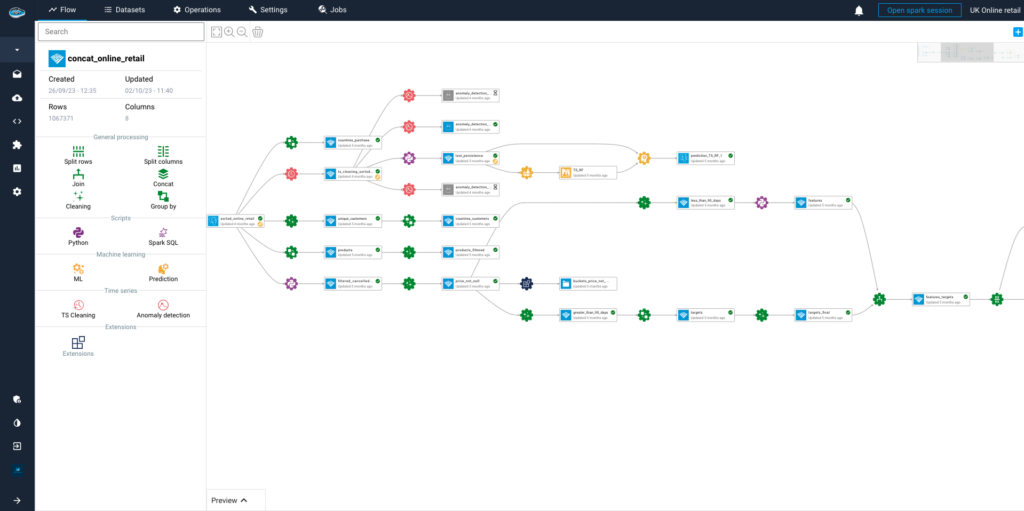
Here’s an in-depth look at the key features and advantages of this innovative solution:
1- Multi-Sensor Data Fusion for Unified Threat Detection
A variety of sensors are used in modern airspace monitoring, including radars for long-range detection, radio frequency detectors for signal interception, visual cameras for identification, and acoustic arrays for drone noise signature recognition. When used alone, these sensors offer useful but insufficient images. Urban canyons may conceal low-flying drones that radar may miss, and autonomous UAVs without active communication signals are impossible for RF detectors to identify.
By combining these disparate data streams into a single, cohesive operational picture, papAI resolves this issue. It aligns and connects information from all sensors using sophisticated machine learning techniques to more accurately and confidently identify any threats. By reducing false positives, this multi-layered fusion makes sure that no one sensor failure jeopardises the efficacy of the entire system. as the sophistication of drone threats increases.
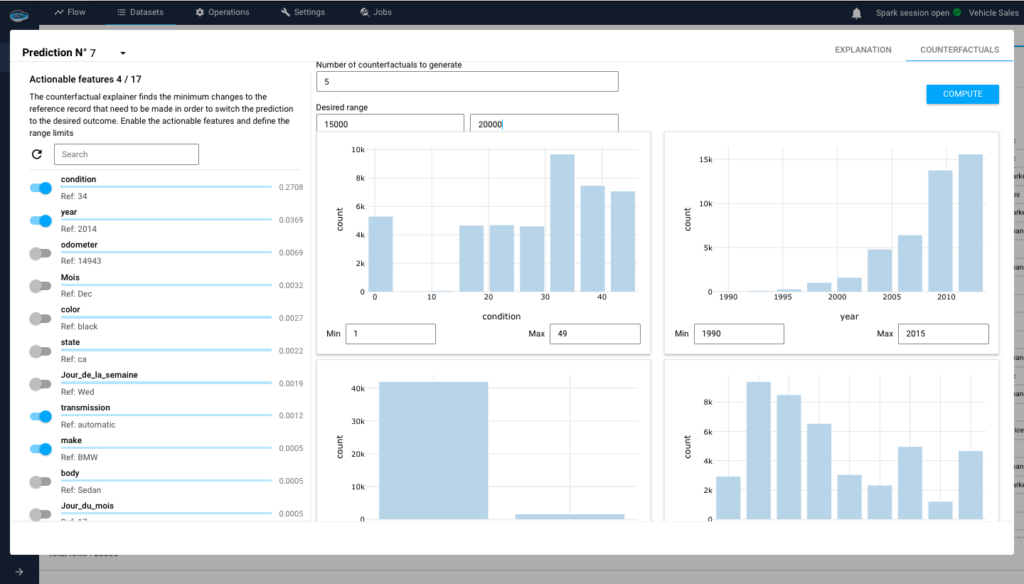
NER/RE machine learning tasks
2- Scalable Architecture for Massive Data Processing
Massive amounts of sensor data are produced by anti-drone systems placed in expansive locations, such airports, military installations, or national boundaries. An extremely scalable infrastructure is needed to process this data in real time without experiencing performance deterioration. Scalability is a fundamental component of papAI.
Large datasets from several monitoring locations can be processed in parallel because to its networked architecture. As a result, defense teams can use papAI to provide seamless coverage across large geographic areas without taxing system resources. Elastic scaling, which enables dynamic adjustments of computational power to match the demands of high-traffic periods or multi-drone invasions, is another benefit of its cloud-ready design. Defense agencies getting ready for increasingly data-intensive operations will find papAI to be the perfect answer thanks to this capacity.
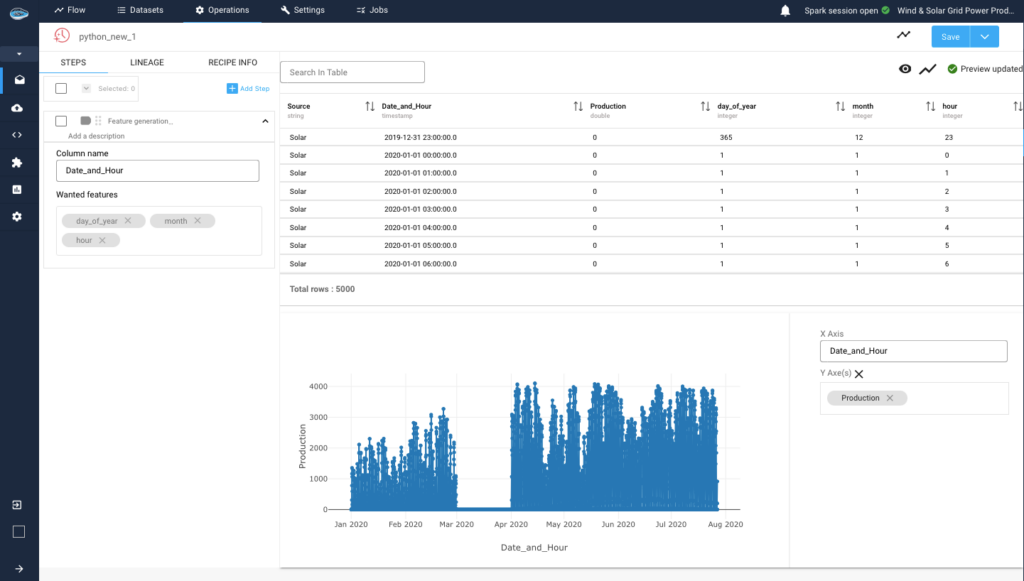
local interpretability of a classifier with feature text
3- Customizable AI Models for Adaptive Defense
Drone technology is advancing quickly, and enemies are always creating new UAV designs and strategies to get beyond traditional defenses. By giving defense teams the resources to create, train, and implement unique AI models, papAI tackles this problem.
Teams can develop machine learning models within its user-friendly interface that are focused on identifying particular drone kinds or distinguishing distinctive flying patterns. To keep the system successful against new threats, these models can be updated on a regular basis with fresh data from simulations or field operations. A flexible, iterative approach to model creation that is customised for every operational context is made possible by papAI, which supports both supervised and unsupervised learning workflows.
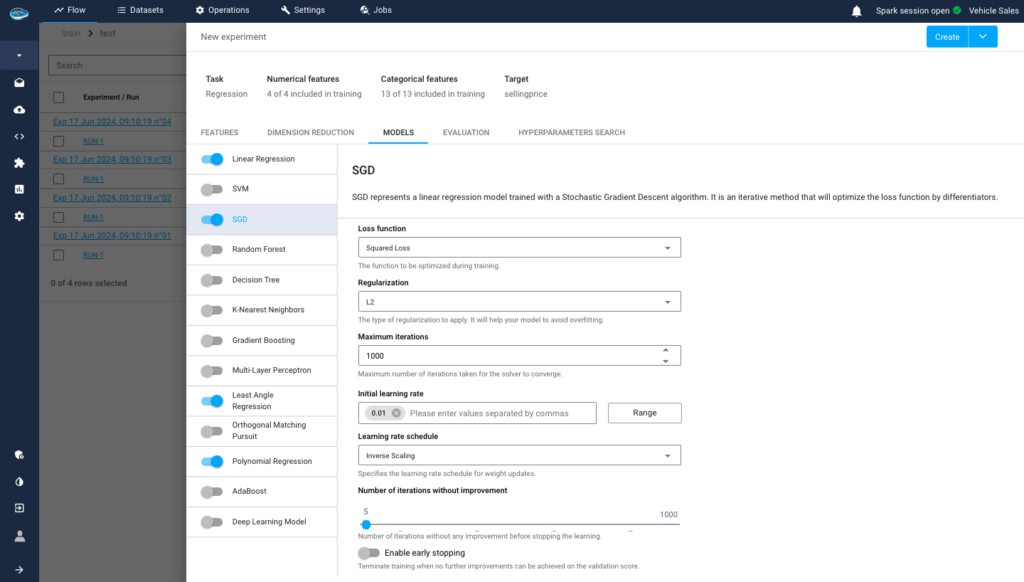
Survival Analysis for Machine Life Prediction
4- Explainable AI for Transparent Decision-Making
Before acting in high-stakes defense situations, operators must comprehend the reasoning behind an AI system’s recommendation. Decisions made by opaque black-box AI systems can erode trust and cause delays in reactions.
PapAI’s integrated explainability features help it get beyond this obstacle. When a drone is spotted, operators are given easily comprehensible information on the detection process, including which sensors were most important in classifying the drone, whose flight patterns or radio frequency signatures were found, and the reasons for the recommendation of a particular countermeasure. In both military and civilian defense sectors, this transparency not only promotes accountability and regulatory compliance but also builds trust. By combining human judgement with AI precision, operators are enabled to make well-informed judgements more quickly.
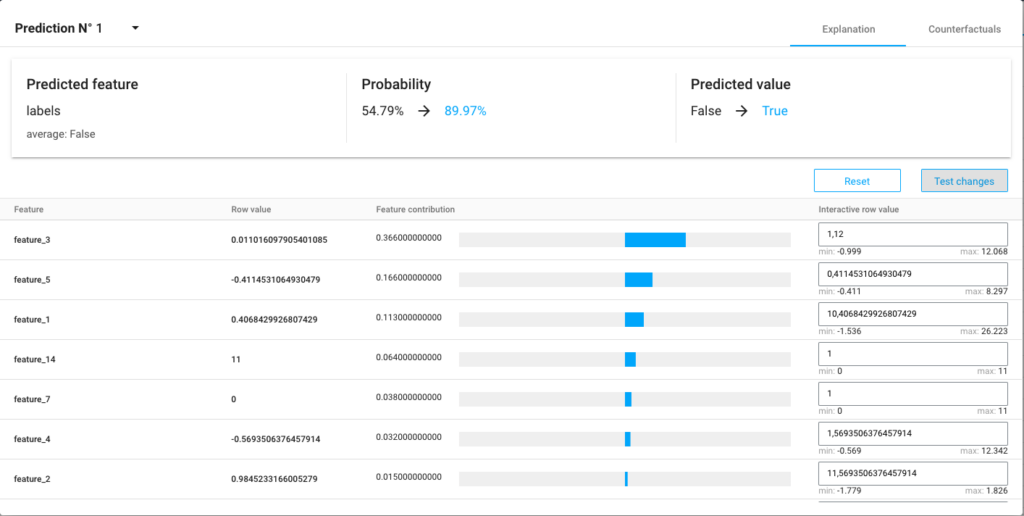
Geospatial analysis from papai
Leverage papAI's AI Capabilities for Advanced Situational Awareness Performance
AI-powered anti-drone technologies are now essential in the quickly changing threat landscape of today. To provide a thorough, flexible defense against new drone threats, Datategy’s papAI platform leverages state-of-the-art technologies like as multi-sensor data fusion, scalable infrastructures, adaptable AI models, and explainable insights. PapAI enables security teams to identify, evaluate, and eliminate drone invasions with unparalleled speed and accuracy by converting complex data into actionable intelligence.
Ready to experience how papAI can enhance your airspace security and future-proof your defense capabilities? Book a demo today and discover how Datategy is redefining the future of anti-drone technology.
AI-powered anti-drone systems use artificial intelligence to detect, track, and neutralize unauthorized drones. By combining sensor data and advanced algorithms, these systems can quickly identify potential threats, classify drone types, and recommend appropriate countermeasures with greater accuracy than traditional solutions.
AI enables real-time analysis of complex data from multiple sensors, reduces false positives, and predicts drone behavior. As drones become more autonomous and harder to detect, AI ensures defense systems remain effective by adapting to new tactics and technologies faster than manual or rule-based systems.
Key challenges include processing large-scale, noisy data from diverse sensors, ensuring real-time response capabilities, and maintaining accuracy against evolving drone technologies. Continuous model updates, scalable architectures, and explainable AI are critical to overcoming these hurdles and ensuring operational reliability.
Unlike rigid, single-function systems, papAI is designed as a flexible AI platform. It integrates heterogeneous sensor data, enables predictive analytics for early warning, and offers explainable AI features. These capabilities transform it from a reactive detection tool into a proactive airspace security solution that supports both Proof-of-Concept projects and future real-time deployments.
Interested in discovering papAI?
Watch our platform in action now
AI’s Role in Translating Complex Defence Documentation
AI’s Role in Translating Complex Defence Documentation The defence sector...
Read MoreHow AI Transforms Technical Documentation in Medical Devices and Life Sciences
How AI Transforms Technical Documentation in Medical Devices and Life...
Read MoreDatategy and Alpha X Join Forces to Strengthen AI-Driven Governance Across EMEA
Datategy and Alpha X Join Forces to Strengthen AI-Driven Governance...
Read More